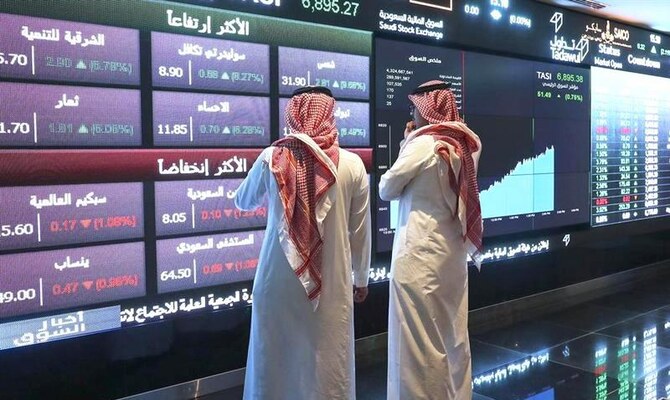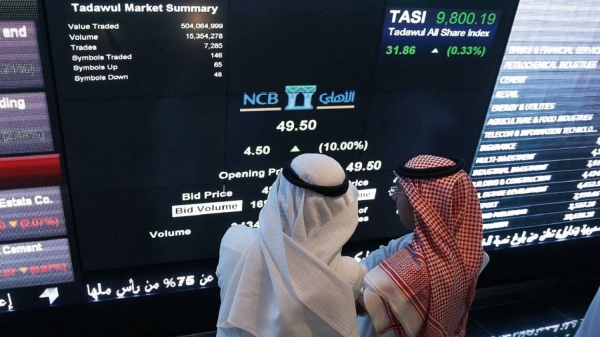Riyadh, March 4, 2025 – The Saudi Arabian stock market closed higher today, with the Tadawul All Share Index (TASI) rising by 0.73%. This positive movement defied the downward trends observed in most Gulf markets, which have been grappling with the impact of global trade uncertainties and mixed corporate earnings. The TASI’s performance reflects a combination of strong sectoral gains, investor confidence in the Kingdom’s economic outlook, and strategic initiatives aimed at enhancing market attractiveness.
This rise comes against the backdrop of a complex global economic environment marked by fears of a potential trade war, fluctuations in oil prices, and mixed signals from major economies. Investors have been closely monitoring developments in the global trade landscape, particularly following new tariff announcements by the United States, which have heightened concerns about potential disruptions in international trade flows. Despite these challenges, the resilience of the Saudi market highlights the relative strength of its economy and the effectiveness of its strategic initiatives.
Sectoral Performance Drives TASI’s Gains

Banking Sector Boosts Market Sentiment
A significant contributor to TASI’s rise was the banking sector, which witnessed robust gains as major banks reported stronger-than-expected earnings. Al Rajhi Bank and Saudi National Bank, two of the largest financial institutions in the Kingdom, saw their shares rise substantially. This positive movement was supported by favorable economic conditions, including rising interest rates and increased lending activity. Analysts noted that the banking sector’s performance reflects solid fundamentals, with improved asset quality and growing profitability margins.
Additionally, the banking sector has been benefiting from increased government spending and ongoing mega-projects under the Vision 2030 initiative. These projects have boosted demand for corporate lending and financial services, further strengthening investor confidence in the sector’s growth prospects. The introduction of new financial regulations aimed at enhancing transparency and market efficiency has also played a role in attracting institutional investors.
Petrochemical Sector Sees Renewed Optimism
The petrochemical sector, a cornerstone of Saudi Arabia’s economy, also contributed positively to the TASI’s performance. Shares of Saudi Basic Industries Corp (SABIC) and other leading petrochemical companies rose, buoyed by optimistic earnings forecasts and rising global demand for chemicals. According to industry reports, the sector is expected to witness a 74% growth in profits for 2025, driven by higher product prices and improved operational efficiencies.
The rebound in oil prices has further enhanced the outlook for petrochemical companies, given the sector’s close linkage to the energy market. With Brent crude stabilizing above $80 per barrel, the positive sentiment has spilled over into petrochemical stocks. Moreover, the ongoing diversification efforts, including investments in specialty chemicals and downstream industries, have positioned Saudi companies to capture new market opportunities globally.Lebanese President Joseph Aoun’s Landmark Visit to Saudi Arabia: A Step Towards Reconciliation
Resilience Amidst Regional Pressures
Mixed Performance in the Gulf Markets
In contrast to the positive performance of TASI, other major Gulf markets closed in negative territory. The Dubai Financial Market’s main share index fell by 0.2%, weighed down by declines in real estate and financial stocks. Emaar Properties, a leading real estate developer in Dubai, saw its shares drop following a cautious outlook for the sector amidst rising interest rates and regulatory challenges.
Similarly, the Qatari stock market witnessed a decline of 0.5%, with pressure on industrial and banking stocks. Investors appeared to be factoring in concerns about potential geopolitical risks in the region, including uncertainties related to energy exports and trade flows.
The divergent performance between Saudi Arabia and other Gulf markets highlights the relative strength of the Kingdom’s economic fundamentals. Analysts pointed out that Saudi Arabia’s ongoing structural reforms, focused on reducing oil dependency and expanding non-oil sectors, have helped enhance investor confidence and market resilience.
Key Drivers of Market Confidence
Vision 2030 Initiatives and Economic Diversification
The gains in the Saudi stock market can be attributed to the continued progress of Vision 2030 initiatives, which aim to diversify the economy and reduce its reliance on oil revenues. Major projects, including the NEOM smart city, the Red Sea tourism initiative, and investments in renewable energy, have attracted significant domestic and foreign investments.
The Public Investment Fund (PIF), Saudi Arabia’s sovereign wealth fund, has played a pivotal role in driving market confidence. By investing in strategic sectors such as technology, logistics, and green energy, the PIF has not only supported the local stock market but also signaled a long-term commitment to economic transformation.
Foreign Investments and Market Reforms
Recent reforms to open the Saudi stock market to foreign investors have also been a key factor behind the TASI’s upward trend. The inclusion of Saudi stocks in global benchmarks like the MSCI Emerging Markets Index has led to substantial inflows of foreign capital. Analysts estimate that foreign ownership of Saudi equities has reached record levels, reflecting growing confidence in the Kingdom’s regulatory environment and growth prospects.
Furthermore, the implementation of advanced trading systems and enhanced corporate governance standards has improved market efficiency and transparency. The Capital Market Authority’s efforts to streamline IPO processes and encourage listings from high-growth sectors such as technology and healthcare have broadened the market’s appeal.
Challenges and Risks Ahead
Global Trade Tensions and Oil Price Volatility
Despite the positive performance, risks remain for the Saudi stock market. Global trade tensions, particularly between the United States and China, pose a potential threat to export-oriented sectors. Any escalation in trade barriers could impact demand for petrochemicals and other key Saudi exports.
Oil price volatility is another significant risk factor. While prices have stabilized recently, any sharp decline could affect government revenues and, by extension, investor sentiment. The Kingdom’s commitment to the OPEC+ agreement on production cuts will be a critical factor to watch in the coming months.
Interest Rate Dynamics and Inflation Concerns
Rising global interest rates could also present challenges, particularly for sectors reliant on debt financing. Higher borrowing costs may weigh on corporate profitability and investor sentiment. Additionally, inflationary pressures, driven by higher import costs and increased consumer demand, could impact consumer-facing sectors such as retail and hospitality.
Outlook and Strategic Focus
Positive Momentum with Caution
Looking ahead, analysts maintain a cautiously optimistic outlook for the Saudi stock market. The combination of strong sectoral fundamentals, ongoing economic reforms, and supportive government policies is expected to sustain positive momentum in the near term. The banking and petrochemical sectors, in particular, are seen as key drivers of market performance.
However, the broader global economic landscape remains a source of uncertainty. Investors are likely to keep a close eye on developments in global trade policies, oil prices, and interest rates. A prudent approach focusing on diversified investments and risk management is expected to characterize market behavior in the coming months.
Conclusion
The 0.73% rise in the Tadawul All Share Index highlights the resilience of Saudi Arabia’s stock market amidst a challenging global environment. The strong performance of the banking and petrochemical sectors, coupled with strategic reforms under Vision 2030, has bolstered investor confidence. While risks related to global trade tensions and oil price volatility remain, the Kingdom’s proactive economic policies and diversification efforts provide a solid foundation for sustainable growth. As regional markets navigate through uncertainties, Saudi Arabia’s market appears well-positioned to maintain its upward trajectory.
Lebanese President Joseph Aoun’s Landmark Visit to Saudi Arabia: A Step Towards Reconciliation



